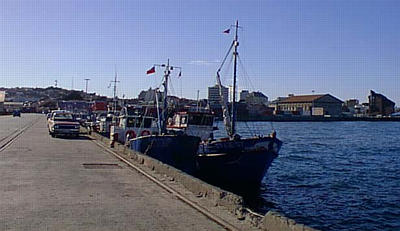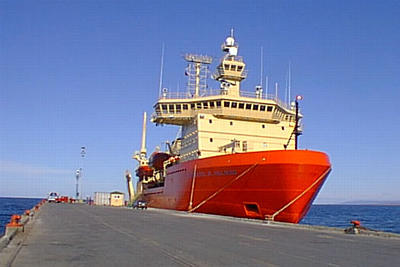
|
|
25 March, 1999
March 25, 1999
Hello from Punta Arenas! We officially docked at Punta Arenas at about
6:30 this morning . . . which was quite a bit earlier than we expected. We
made great time coming through the Strait of Magellan, and we had a
favorable current that increased our speed. After we docked, the customs
officials came aboard the ship to check all of our passports and the cargo
that we are carrying. By about 10:00 a.m., we were free to leave the ship
and explore around the town.
Punta Arenas is the most southerly city in Chile. It has a population of
about 110,000, and it lies about halfway between the Atlantic and Pacific
oceans on the north side of the Strait of Magellan. Punta Arenas is a
center for the local sheep farming and fishing industries. We saw lots of
fishing boats, but we're too close to the center of town to see any of the
sheep. Spanish is the official language of Chile. Although I don't speak
Spanish, I had a very successful day of exchanging money, going to the
telephone store (you don't make phone calls from a phone booth, you have to
go to a phone store), ordering lunch at a restaurant, and going to the
grocery store. Tomorrow, several of us are hoping to sign up for a tour to
go see the local penguins.
So, what species of penguins can be found in southern Chile? Magellanic
penguins! Magellanic penguins are one of four species of penguins that
belong to the Spheniscus (or wedge-shaped) genus. These four species of
ringed, or harlequin, penguins live mainly in cool temperate to tropical
climate zones in South America and Africa. The African Black-footed, or
Jackass, penguin lives around the southern tip of Africa. The Peruvian
penguin, also known as the Humboldt penguin, lives on the coast of Peru.
The Galapagos penguin is the smallest and most unusual of this group, and
it breeds exclusively on the Galapagos Islands, which are a national park
of Ecuador that is located on the equator. All of these penguins have dark
gray rings or bands that loop over their white chests and down their
flanks. The Magellanic and Galapagos penguins have two dark bands, while
the Black-footed and Peruvian penguins only have one.
Magellanic penguins are the largest of the four ringed penguins and they
are also the most numerous. They are about 27 inches in length, and their
average weight is about 7.7 pounds. Bare skin can be seen around their
eyes, and this helps in the dispersal of heat when the bird leaves the cold
water to rest on the relatively warm shore. Magellanic penguin colonies
are underground, and the penguins dig burrows in which they lay their eggs.
Magellanic penguins are partial to eating sardines, but they also eat other
small fish, along with squid and cuttlefish.
Before we finish this expedition, there are two more scientists that I want
to introduce. I wanted to take some time in today's journal to introduce
you to our Chief Scientist and Principle Investigator, Dr. John Anderson.
He is 54 years old, and he is from Saraland, Alabama. He and his wife,
Doris, now live in Houston, Texas, and work at Rice University. Doris is
the Assistant to the Dean of Architecture, and John is a professor in the
Department of Geology and Geophysics. They have two children -- a 25 year
old daughter and a 32 year old son. As John was growing up, his father
(who loved to fish and was a professional fisherman at one time) instilled
in him a love for the sea. His mother was an elementary school teacher and
she instilled in him a love for knowledge. He first became interested in
science in high school, and he parcticularly enjoyed oceanography and marine
biology. John graduated from the University of South Alabama with a degree
in Geology in 1968. At that time, he was one of the first two geology
majors to graduate from the school. He went to graduate school at the
University of New Mexico. During his second year there, he was asked by
one of the professors if he wanted to go to Antarctica -- so his first trip
to Antarctica was in 1970. He followed that same professor to Florida
State where John completed his Ph.D. in Geology. After graduation, he
taught at Hope College in Holland, Michigan, for three years. In 1975 he
was hired to teach at Rice University, and he has been there ever since!
It wasn't until 1978 that John was able to return to Antarctica. This trip
makes his 20th trip to the southernmost continent! John has seen lots of
changes in Antarctic research since his earlier years. At first, there was
lots of exploratory work and the emphasis was on the United States presence
in Antarctica. Now, the emphasis is on conducting research and science in
Antarctica . . . and the Nathaniel B. Palmer is the premier vessel in for
such research. The capabilities of this ship, along with the advances in
technology and equipment, make the research much more productive than it
ever has been in the past. John is very excited about the data that has
been gathered this cruise, and he is looking forward to returning and
conducting more Antarctic research in the future. For relaxation, John and
his wife enjoy fishing and walking on the beach at their weekend retreat on
Galveston Island.
Tomorrow, I'll introduce our last scientist. Do you know who that is?
I'll also write about our adventures in Punta Arenas. On Friday, we'll be
leaving for the United States. I'll write the last journal entry from
home, and it will be posted sometime on Sunday. I hope that you're
enjoying this expedition as much as I am! Until tomorrow . . .
Kim Giesting
Latitude: 53 degrees 10 minutes South
Longitude: 70 degrees 54 minutes West
(All of our other instruments are turned off while we are in port)

Dr. John Anderson is standing next to a map showing our entire track line for this expedition.

There are some of the fishing boats lining the dock in Punta Arenas. You can see part of the city in the background.

Here is the Nathaniel B. Palmer at the dock in Punta Arenas. If you look carefully, you can see a car on the dock beside the ship.
Contact the TEA in the field at
.
If you cannot connect through your browser, copy the
TEA's e-mail address in the "To:" line of
your favorite e-mail package.
|
